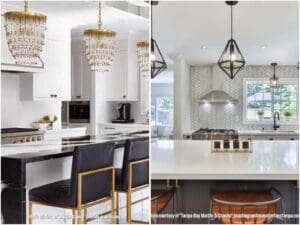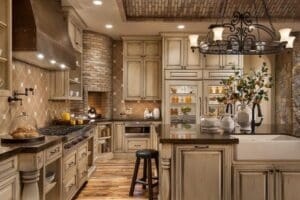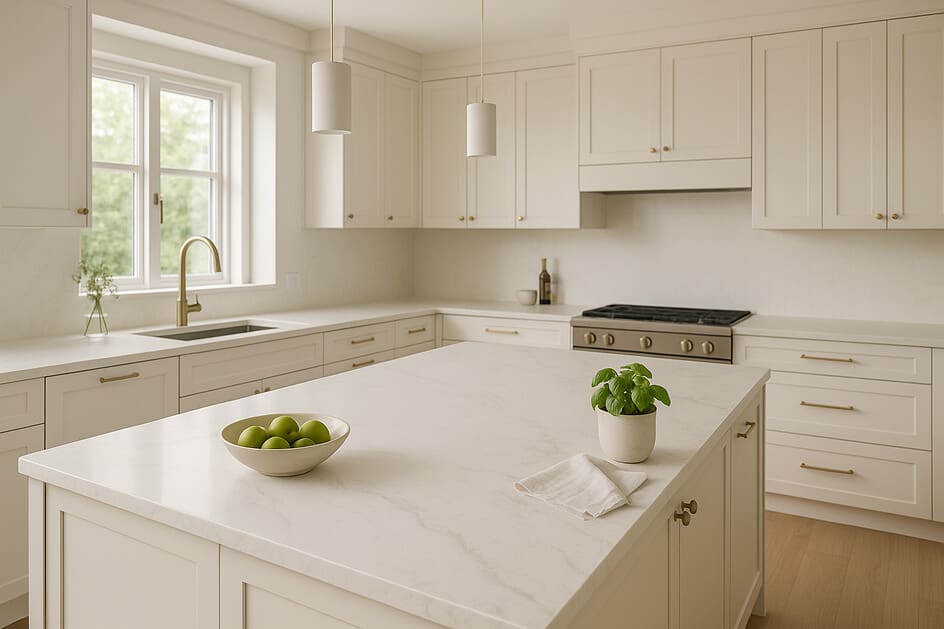
Introduction
For almost eight years, we had a ceramic countertop in our kitchen. It looked decent—until the grout started to darken and the edges began to crack. Recently, my husband and I finally decided to replace it. I chose quartz, and it turned out to be perfect for our family. But when I first started digging into the topic, I discovered that there’s not just quartz, but also engineered quartz—and that’s a whole different story.
Back then, I had no idea how different engineered quartz is from natural stone, or how many details are hidden behind the phrase “manmade material.” Today, I want to share everything I’ve learned—in simple, clear language, no jargon. I’ll explain how artificial quartz countertops differ from other options, when they’re a great choice (and when they’re not), which brands are worth considering, and what to look out for before you buy.
If you’re in the decision-making stage like I once was—don’t rush. This article offers an honest look at the pros and cons, answers to frequently asked questions, and real-life examples. Let’s break down what engineered quartz really is—and whether it’s the right fit for your home.
What Is Engineered Quartz and How Is It Different From Other Materials?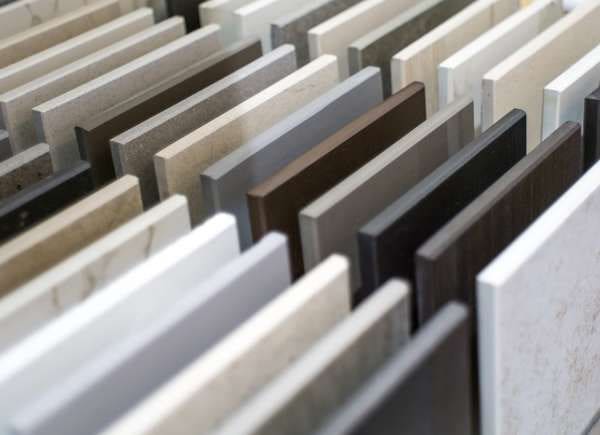
When I first heard about engineered quartz, I got confused. I had already picked out a quartz countertop, but then I noticed the product description said: engineered stone. That threw me off—was it quartz or not? Artificial or natural?
Turns out, engineered quartz is a manmade material made from up to 93% natural quartz particles, held together with resins and pigments. Because of this, it combines the strength of natural stone with a hygienic, uniform structure.
But here’s the thing: the market is full of similar-sounding terms, and they’re often used interchangeably. Here’s a quick guide to help you make sense of it all:
- Artificial quartz countertops — the same as engineered quartz. Just a different name.
- Artificial stone countertops — a broader category that can include acrylic, polyester, even concrete.
- Composite stone countertops — another general term for blends of minerals and resins.
- Engineered composite countertops — a catch-all for hand-crafted materials made from natural particles.
- Engineered quartz stone countertops — specifically made with quartz particles as the main ingredient.
- Synthetic stone countertops — often budget options with lower durability and minimal texture.
- Fake stone countertop material — cheap imitations that may look nice at first, but degrade quickly.
Tip: Always ask the seller for the exact composition. Manufactured quartz and manmade quartz countertops aren’t plastic or laminate—they’re true stone-based surfaces, just created by people. What matters is not confusing them with cheaper manufactured countertops that look like quartz but aren’t quartz at all.
If you're looking for durability, style, and low maintenance, engineered countertops with a quartz base are a fantastic choice. In the next section, we’ll look at how they compare to other materials—and when they shine (or fall short).
Engineered Quartz vs. Natural Stone: What’s the Difference?
When I first started looking into countertop materials, I assumed quartz was just a type of natural stone. Then I came across the term engineered quartz and realized—it’s not the same as natural quartz. And that difference is crucial when it comes to maintenance, appearance, and even durability.
To keep things clear, let’s compare engineered quartz vs quartz—and throw in granite, marble, and quartzite as well, since they’re often considered alternatives.
What Exactly Are We Comparing?
|
Property
|
Engineered Quartz
|
Natural Quartz
|
Granite
|
Marble
|
Quartzite
|
|
Origin
|
Manmade material
|
Natural mineral
|
Natural stone
|
Natural stone
|
Natural stone
|
|
Composition
|
Quartz particles + resin
|
Solid mineral form
|
Minerals + quartz
|
Calcium carbonate
|
Dense quartz
|
|
Porosity
|
None
|
Yes
|
Yes
|
Yes
|
Low
|
|
Needs Sealing
|
No
|
Yes
|
Yes
|
Yes
|
Sometimes
|
|
Maintenance
|
Very easy
|
Moderate
|
Moderate
|
Difficult
|
Moderate
|
|
Stain Resistance
|
Excellent
|
Average
|
Average
|
Low
|
Excellent
|
|
Heat Resistance
|
Moderate
|
High
|
High
|
Moderate
|
High
|
|
UV Resistance
|
Moderate
|
High
|
High
|
Low
|
High
|
|
Design & Colors
|
Wide selection
|
Natural veining
|
Natural
|
Natural
|
Natural
|
|
Price
|
Relatively affordable
|
High
|
Moderate
|
High
|
High
|
What won me over was the consistency of the pattern in engineered quartz—I could choose the exact tone and veining I wanted to match my cabinets. With natural stone, there’s always some unpredictability: it may look different than the showroom sample.
When Is Engineered Quartz the Better Choice?
Go with a manmade quartz countertop if you want:
- A uniform color and style
- Low-maintenance care (especially with kids in the house)
- No sealing required
- Water resistance and hygienic surfaces
But if your kitchen has floor-to-ceiling windows—or you tend to place hot pans directly on your counters—you might want to consider quartzite or granite instead. They offer better heat and UV resistance.
“We put engineered quartz in a kitchen with floor-to-ceiling windows - after a year, the dark countertop had discolored a bit. If I were to choose again, I would go with light-colored or quartzite” — u/stoneandshade (Reddit)
Looking for a reliable, low-maintenance surface that looks great every day? Then, engineered quartz is an excellent pick. But if you value one-of-a-kind natural patterns and don’t mind the upkeep—natural stone still deserves your attention.
In the next section, I’ll talk about where engineered quartz works best—and where it might not. This could really shape your final decision!
Where Engineered Quartz Countertops Work Best
When we were choosing a new countertop material for our kitchen, I thought not only about how it looked, but also how it would perform in different spaces—like the kitchen, the bathroom, or on an island. What I found was that artificial stone countertops are incredibly versatile, but there are a few things to keep in mind.
For Kitchens
Kitchen countertops engineered stone are probably the most popular and sensible choice. The surface resists:
- stains from coffee, wine, and spices
- moisture, grease, and acids
- mechanical damage during regular use
I saw it firsthand: after six months of daily cooking, there’s not a single stain on our quartz countertop, and everything wipes clean with just a cloth. That’s something I really missed with ceramic.
Tip: Don’t forget to use trivets. While engineered quartz can handle temps up to 300℉, a sudden thermal shock might cause micro-cracks.
For Bathrooms
People often underestimate how great artificial quartz countertops are in bathrooms. But the truth is:
- they’re water-resistant
- easy to clean (even from toothpaste and cosmetics)
- and stay looking fresh for years
For Kitchen Islands and Bar Areas
If you want that wow-factor—go with an engineered stone top for your kitchen island. Especially eye-catching is the “waterfall” style (when the stone flows down the side). My neighbor recently installed manufactured countertops that look like quartz in a gray concrete effect—and guests are always impressed.
When Another Material Might Be Better
There are a few cases where engineered quartz may not be ideal:
- Outdoor kitchens with direct sun exposure — quartz may fade (go with granite or quartzite instead)
- Fireplaces or areas next to cooktops — where sudden, high heat is a risk (natural stone is better)
- Eco raw projects — where you want a raw, unpolished natural stone look with texture and no gloss
¹ Eco raw is an interior style focused on natural textures and minimal surface treatment. It’s popular in modern eco-homes and sustainable projects.
If you’re planning a remodel and don’t want regrets later, engineered countertops are a safe bet for most zones. Just be sure to factor in lighting, room style, and expected wear.
And for a smooth project from the very beginning—find a contractor through The First National Ranking of Stone Countertop Fabricators and Installers in the U.S. It’s easy to find a vetted professional in your city. Many of them don’t just handle installation—they help you pick materials and answer all your questions before you place an order. Sometimes, one consultation can save you thousands—and a lot of stress.
Pros and Cons of Engineered Quartz Countertops
When I was choosing a material for our new countertop, I seriously considered engineered quartz. I was drawn to its practicality, modern look, and the wide range of design options. I read dozens of reviews, browsed forums, and spoke with contractors and designers—what I found was a pretty honest picture. Artificial quartz countertops really do have a lot of advantages, but there are a few things you should know upfront to avoid disappointment after installation.
Advantages
- Stain Resistance
I cook a lot of sauces, brew coffee, and even make jam from fresh berries—so spills happen. But with engineered countertops, it’s not a problem. Since they’re non-porous, all it takes is a quick wipe with a cloth—no stains left behind.
- Hygiene
No pores or microcracks means no bacteria or mold buildup. That’s especially important if you have kids or pets at home.
- No Sealing Required
Unlike granite or marble, which need regular sealing, engineered quartz doesn’t require any of that. It saves you both time and money.
- Wide Range of Colors and Textures
From soft white veining to concrete gray and warm beige, brands like Cambria and Vadara offer dozens of options. It’s easy to match your kitchen style.
- Strength and Stability
Man made stone countertops don’t chip or crack under normal use and can handle mechanical pressure. And their uniform structure eliminates the “unpleasant surprises” that sometimes come with natural stone.
Drawbacks
- Sensitive to Heat
Don’t place hot pans directly on the surface. Even though it’s rated to withstand up to 300℉, sudden heat can damage the binding resin.
- UV Sensitivity
Dark engineered quartz stone countertops can fade over time with prolonged sun exposure. If your kitchen faces south, go with lighter tones or use UV-protective shades.
- Repair Can Be Tricky
If you chip or crack the surface, man made quartz countertops aren’t easy to fix. You’ll need a pro and special resin—which can cost between $150 and $300.
“We have young children and I knew I wanted a surface that could simply be wiped down. Artificial stone countertops were the best thing we installed in our kitchen. My friend got granite - and over time, she regretted the choice.” — u/EmmyWatsss9 (Reddit)
Is Engineered Quartz Worth It?
If you’re looking for a balance between beauty and practicality, composite stone countertops with a quartz base are a solid option. They’re great for everyday use, resistant to most risks, and ideal for families with kids. Yes, there are a few things to watch out for—like with any material. But knowing them ahead of time can help you avoid most problems.
In the next section, we’ll dive into colors, styles, and textures—and how to pick a countertop that’ll feel like a seamless part of your home for years to come.
Colors, Textures, and Styles: What to Choose?
If you’re interested in quartz countertop trends, I’ve already talked about the most popular options in my article “How to choose a stylish and durable countertop for your kitchen: Trendy Solutions for 2025.” But here, I want to dive deeper into how to choose the right color, texture, and style—especially if you’re leaning toward engineered quartz.
When I first started exploring this material, I was amazed at how visually diverse it is. But since I’m not a designer, I didn’t just want to admire pretty slabs in a showroom—I wanted to understand what’s really current and practical in 2025. I spent hours on Pinterest, Instagram, design blogs, and manufacturer websites to get the full picture. Here’s what designers recommend most often.
Most Popular Styles
According to open sources, these artificial quartz countertops styles are leading the charts this year:
- White with gray veining (Calacatta style) — visually enlarges the space and brightens up the kitchen
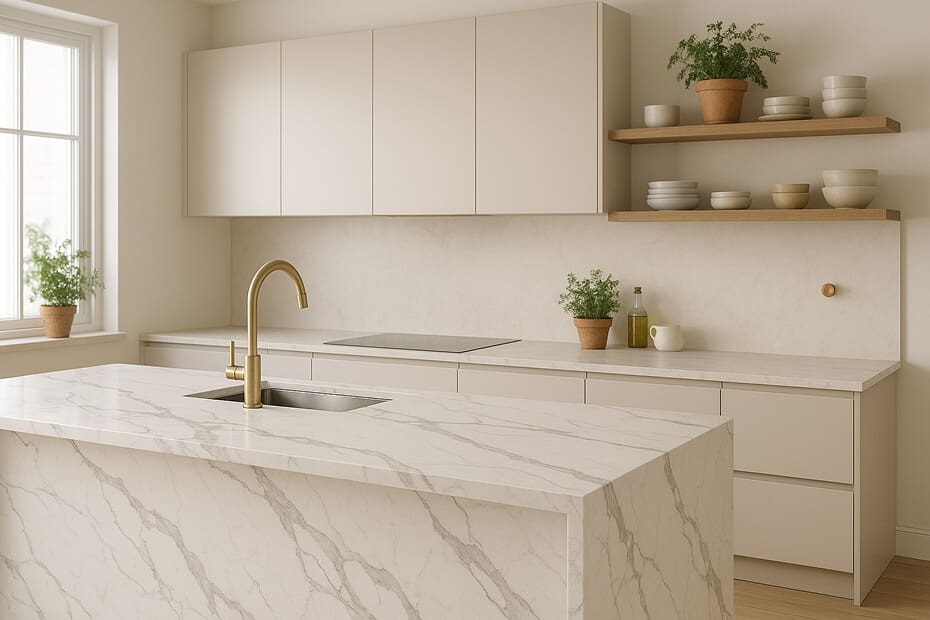
- Light beige with golden veining — a warm and cozy look, popular in farmhouse and transitional interiors

- Concrete gray — fits perfectly in Scandinavian or industrial design
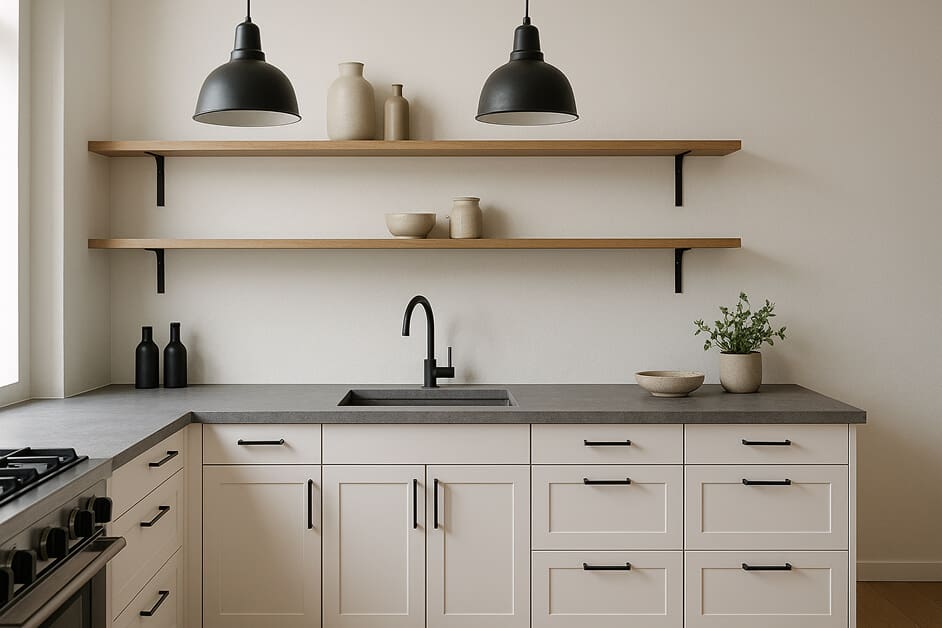
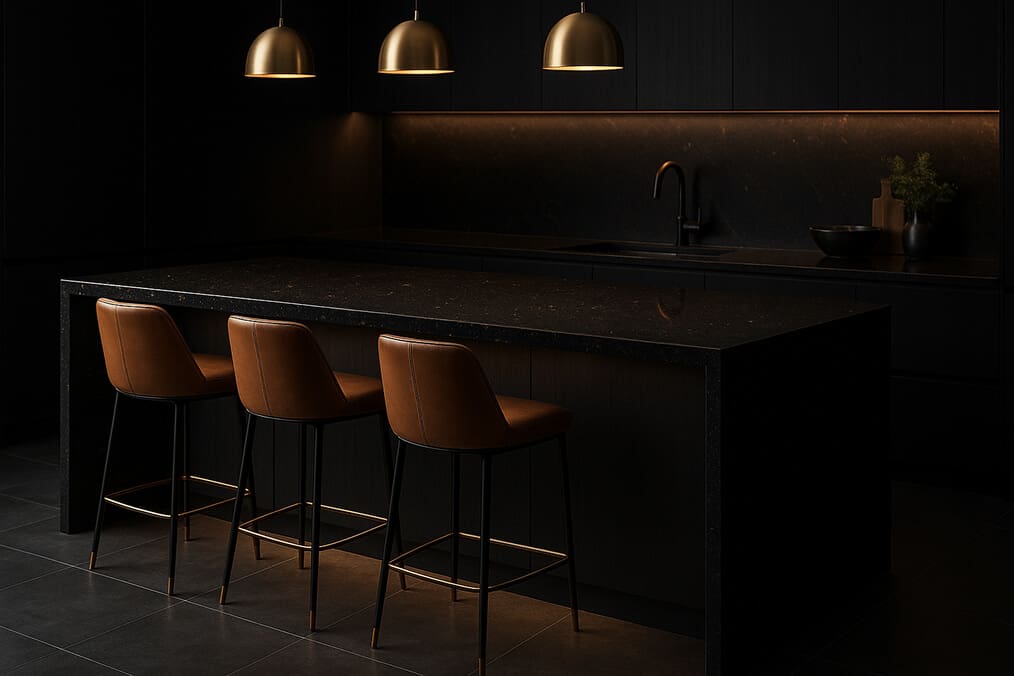
- Limestone, travertine, or slate look-alikes — great for those who love a natural, earthy aesthetics

Finish and Surface Texture
Many brands now offer engineered quartz stone countertops not only in a glossy finish but also in matte or lightly textured "stone-like" options. Designers often recommend these if you’re going for a more organic or understated look.
What to Keep in Mind When Choosing?
- Start with your kitchen’s color palette — the countertop should complement, not clash
- Consider lighting: Glossy finishes reflect more light but also highlight fingerprints; matte is more practical for high-traffic kitchens
- Always ask for a physical sample and view it under different lighting conditions
- Synthetic quartz countertops can look quite different in photos versus real life—don’t make decisions based on catalogs alone
How Much Do Engineered Quartz Countertops Cost? A Complete Breakdown
When I first started researching prices, I thought it would be simple: just check the price per square foot—done. But in reality, artificial quartz countertops are like an iceberg—most of the cost is hidden beneath the surface. To avoid surprises, I put together a complete cost breakdown—from the material itself to the little things like edge finishes and measurement visits.
Base Material Cost*
As of 2025, prices for manufactured quartz start at around $55–$70 per square foot for basic collections. Premium options from Caesarstone, Cambria, or Vadara can cost up to $130–$150 per square foot, especially if you choose a slab with bold veining or a unique texture.
Installation Costs*
Professional installation of engineered countertops typically ranges from $35 to $85 per square foot, depending on:
- your location
- the complexity of sink and cooktop cutouts
- kitchen layout (U-shape, L-shape, etc.)
- whether old countertops need to be removed
“We paid $3,500 for a 45 ft² kitchen. This included everything: the stove, installation, two cutouts, and edging. We thought it would be less, but we forgot to include the apron.” — u/TylerDerddy (Reddit)
Edges, Cutouts, and Additional Costs*
These are often the hidden expenses—especially if you’re only looking at catalog prices.
- Edge profile: a basic eased edge is usually included, but decorative edges (like ogee or bullnose) may add $10–15 per foot
- Undermount sink installation — $150–$250
- Old Countertop Removal — $200–$400, unless it’s included in your contractor’s estimate
- Thicker slabs or waterfall designs on islands — add 10–20% to the material cost
Tip: Ask upfront if measurement and delivery fees are included in the final quote. Some contractors include them by default; others charge separately.
Maintenance Costs
One of the perks of engineered composite countertops is the almost zero upkeep. You don’t need to:
- buy sealant (like you would for granite)
- schedule polishing sessions
- worry about stains from spills
All you need is a soft sponge and a mild cleaner.
So, What’s the Total?*
|
Item
|
Estimated Cost
|
|
Material
|
$55–150/ft²
|
|
Installation
|
$35–85/ft²
|
|
Decorative edge profile
|
+$10–15/ft²
|
|
Sink/cooktop cutout
|
$100–250
|
|
Removal of old countertop
|
$200–400
|
|
Annual maintenance
|
$0–20
|
|
Chip repair (if needed)
|
$150–300
|
If you're looking for a trusted specialist for measurements and installation, don’t go in blind. Check out The First National Ranking of Stone Countertop Fabricators and Installers in the U.S.—it features only vetted companies from across the country.
FAQ: 5 Most Common Questions from Readers
What’s the difference between engineered quartz and natural quartz?
Natural quartz is a mineral found in nature. In its pure form, it’s rarely used for countertops. Engineered quartz, on the other hand, is a blend of quartz particles, resins, and pigments. It’s stronger, non-porous, and doesn’t require sealing. The key is that engineered quartz is purpose-built for kitchens and bathrooms.
Which engineered quartz countertops are the most durable?
According to contractors and customer reviews, brands like Cambria, Caesarstone, and Silestone have the best track records. They offer solid structure, strong resistance to stains and scratches, and they’re NSF and GREENGUARD certified for safety and environmental standards.
Are artificial quartz countertops suitable for bathrooms?
Absolutely. Artificial quartz countertops resist moisture, don’t absorb stains, and require no special maintenance. Light marble-style designs are especially popular in bathrooms—they brighten the space and make it feel larger.
What’s the difference between man-made quartz and composite stone countertops?
Man-made quartz is a specific type of composite stone, with quartz particles as its base. Composite stone countertops is a broader term that can include acrylic, polyester, and other fillers. If durability and resistance are your priorities, stick with quartz-based slabs.
How do you care for a synthetic quartz countertop?
It’s simple: soft cloth + warm water + neutral cleaner. No acids, bleach, or abrasives. If you spill something, wipe it up quickly. And don’t place hot pots directly on the surface—use a trivet, even if the countertop is rated for up to 300℉.
Conclusion
The more I read about countertops, the more I realized: there are so many similar materials on the market, it’s easy to get confused—especially when it comes to artificial stone. I never aimed to become an expert, but I did want to understand what stands behind the term engineered quartz, how it differs from other options, and why it’s talked about so much.
This article is the result of my personal journey. I explored artificial quartz countertops to find answers to my own questions—and along the way, I realized it’s worth sharing. Not because quartz is the “best choice” for everyone, but because it deserves a closer look if you value practicality, durability, and a clean, modern look.
I hope this makes it easier for you to navigate the terminology, spot quality materials over cheap imitations, ask the right questions when speaking with contractors—and make decisions with confidence. Even if you end up choosing granite or quartzite instead of quartz, the most important thing is that it’s a choice you make knowingly.
Also read:
“How to choose a stylish and durable countertop for your kitchen: Trendy Solutions for 2025”
* The price is valid as of May, 2025, published for informational purposes and may differ on the day the article is read. Prices are based on average data from Home Depot, Houzz, HomeAdvisor, and other relevant sources in the U.S.
All images are sourced from Unsplash and Pinterest photo stock or publicly available contractor portfolios. If you believe any image is privately owned and used without proper credit, please contact us at contact@countertopcontractors.com.
Some authors may write under a pseudonym and choose not to disclose their identities for personal reasons. We respect their privacy and simply provide a platform for professional, educational use. We are not responsible for name coincidences with real individuals. All contributors are vetted for expertise, but we advocate for freedom of expression.














